Content for TS 23.558 Word version: 19.2.0
0…
5…
6…
6.2a…
6.2b…
6.3…
6.4…
7…
8…
8.3…
8.3.3…
8.3.3.3…
8.4…
8.4.3…
8.4.4…
8.5…
8.6…
8.6.3…
8.6.4…
8.6.6…
8.7…
8.8…
8.8.2.5…
8.8.2A…
8.8.3…
8.8.4…
8.8.5…
8.9…
8.14…
8.14.3…
8.15…
8.17…
8.17.3…
8.17.4…
8.18…
8.19…
8.20…
9…
A…
A.4…
A.5…
B…
E…
8.17 Support for roaming and federation
8.17.1 General
8.17.2 Procedures
8.17.2.1 General
8.17.2.2 Registration
8.17.2.2.1 General
8.17.2.2.2 ECS registration
8.17.2.2.3 ECS registration update
8.17.2.2.4 ECS de-registration
8.17.2.3 ECS discovery via ECS-ER
8.17.2.3.1 General
8.17.2.3.2 Request-response model
8.17.2.3.3 Subscribe-notify model
8.17.2.3.3.1 General
8.17.2.3.3.2 Subscribe
8.17.2.3.3.3 Notify
8.17.2.3.3.4 Subscription update
8.17.2.3.3.5 Unsubscribe
8.17.2.4 Service provisioning information retrieval
8.17.2.4.1 General
8.17.2.4.2 Procedures
8.17.2.4.2.1 General
8.17.2.4.2.2 Request-response model
8.17.2.4.2.3 Subscribe-notify model
8.17.2.4.2.3.1 General
8.17.2.4.2.3.2 Subscribe
8.17.2.4.2.3.3 Notify
8.17.2.4.2.3.4 Subscription update
8.17.2.4.2.3.5 Unsubscribe
...
...
8.17 Support for roaming and federation |R18| p. 252
8.17.1 General p. 252
This clause describes procedures to support roaming and federation. In this document, roaming and federation are distinguished as follows.
Roaming is a scenario where a UE is served by a visited PLMN. The UE may be served by ECS connected with the VPLMN (i.e., V-ECS). The UE may also be served by ECS connected with the HPLMN (i.e., H-ECS) via local breakout (see clause 6.2a.2) or via home-routed session (see clause 6.2a.3).
Federation is a scenario where a UE consumes edge services involving two or more ECSPs. The architecture for federation support is described in clause 6.2b. Different ECSP's ECSs are connected by EDGE-10 and exchange ECS configuration information and EDN configuration information. A UE may consume federation services while non-roaming or roaming.
8.17.2 Procedures p. 253
8.17.2.1 General p. 253
Following sets of procedures are defined to support roaming and federation:
- Registration;
- ECS discovery via ECS-ER; and
- Service provisioning information retrieval.
8.17.2.2 Registration p. 253
8.17.2.2.1 General p. 253
Following procedures are defined for ECS registration:
- ECS registration procedure;
- ECS registration update procedure; and
- ECS de-registration.
8.17.2.2.2 ECS registration p. 253
ECS registers with the ECS-ER and provides the information included in the ECS profile. Figure 8.17.2.2.2-1 illustrates the procedure.
Pre-conditions:
- The ECS has the address (e.g. URI) of the ECS-ER.
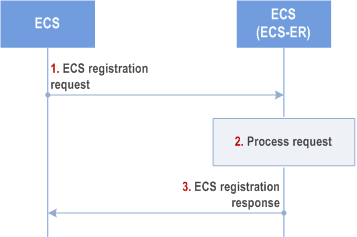
Step 1.
The ECS sends the ECS registration request to the ECS-ER. The request from the ECS includes ECS profile and security credentials. The request may include a proposed expiration time for the registration, and may include list of partner ECSPs that are allowed to receive its information. The request may also include DNN and S-NSSAI information for roaming UEs to establish a PDU session towards the ECS as specified in TS 23.548.
Step 2.
Upon receiving the request from the ECS, the ECS-ER verifies the security credentials of the ECS and stores the ECS registration information received in step 1.
Step 3.
The ECS-ER sends an ECS registration response indicating success or failure of the registration operation. The ECS-ER may provide an expiration time to indicate to the ECS when the registration will automatically expire. To maintain the registration, the ECS sends a registration update request prior to the expiration time. If a registration update request is not received prior to the expiration time, the ECS-ER treats the ECS as implicitly de-registered.
8.17.2.2.3 ECS registration update p. 254
Figure 8.17.2.2.3-1 illustrates the ECS registration update procedure.
Pre-conditions:
- The ECS is registered with the ECS-ER.
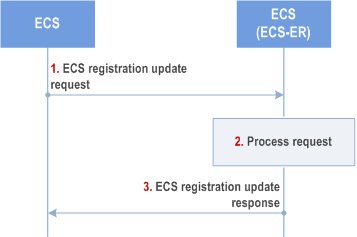
Step 1.
The ECS sends the ECS registration update request to the ECS-ER. The request from the ECS includes security credentials and may include updated ECS profile that may include updated DNN and S-NSSAI information, and an updated list of partner ECSPs that are allowed to receive its information. The request may also include a proposed expiration time for the updated registration.
Step 2.
Upon receiving the request from the ECS, the ECS-ER verifies the security credentials of the ECS and updates the stored the ECS registration information as received in step 1.
Step 3.
The ECS-ER sends an ECS registration update response indicating success or failure of the registration update operation. The ECS-ER may provide an updated expiration time to indicate to the ECS when the updated registration will automatically expire. To maintain the registration, the ECS sends another registration update request prior to the expiration time. If a registration update request is not received prior to the expiration time, the ECS-ER treats the ECS as implicitly de-registered.
8.17.2.2.4 ECS de-registration p. 254
Figure 8.17.2.2.4-1 illustrates the ECS de-registration procedure.
Pre-conditions:
- The ECS is registered with the ECS-ER.
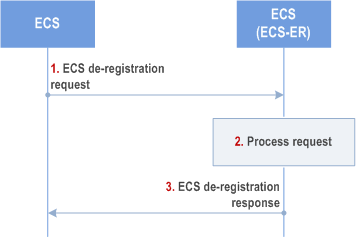
Step 1.
The ECS sends the ECS de-registration request to the ECS-ER. The request from the ECS includes its security credentials.
Step 2.
Upon receiving the request from the ECS, the ECS-ER verifies the security credentials of the ECS and de-registers the ECS.
Step 3.
The ECS-ER sends an ECS de-registration response indicating success or failure of the de-registration operation.
8.17.2.3 ECS discovery via ECS-ER p. 255
8.17.2.3.1 General p. 255
Following procedures are supported for ECS discovery via ECS-ER:
- Request-response procedure;
-
Subscribe-notify procedures, including:
- Subscription procedure;
- Notification procedure;
- Subscription update procedure; and
- Unsubscribe procedure.
8.17.2.3.2 Request-response model p. 255
When required to find a suitable partner ECS, the ECS queries the ECS-ER by providing information such as the location of the UE, applications required by the UE etc. In response the ECS-ER provides ECS profile of partner ECS(s) providing the required application at the location indicated by the ECS. Figure 8.17.2.3.2-1 illustrates the procedure. The procedure is also applicable between ECS of leading ECSP and ECS of partner ECSP.
Pre-conditions:
- The ECS has the address (e.g. URI) of the ECS-ER.
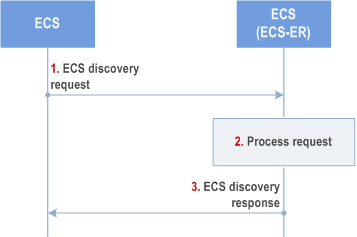
Step 1.
The ECS sends a ECS discovery request to the ECS-ER. The request contains security information of the ECS, and optionally AC profile(s) and UE's current location to filter ECS. If the UE hosting the EEC is roaming in a V-PLMN (determined using the serving PLMN information in the received service provisioning request, or by interacting with the H-PLMN), then the ECS discovery request includes the information of the serving PLMN i.e. the V-PLMN.
Step 2.
The ECS-ER authorizes the received request. If authorized, the ECS-ER processes the request and gathers the information of partner ECS(s) that can satisfy the query parameters received in step 1.
Step 3.
The ECS-ER sends a ECS discovery response to the ECS. The response includes ECS profile of the Partner ECS(s) available in the H-PLMN and/or the V-PLMN, depending on the serving PLMN of the UE as indicated in step 1 and may include DNN and S-NSSAI information for roaming UEs to establish a PDU session to the Partner ECS as specified in TS 23.548. The ECS caches the received information for further use.
8.17.2.3.3 Subscribe-notify model p. 256
8.17.2.3.3.1 General p. 256
Void.
8.17.2.3.3.2 Subscribe p. 256
Figure 8.17.2.3.3.2-1 illustrates the procedure.
Pre-conditions:
- The ECS has the address (e.g. URI) of the ECS-ER.
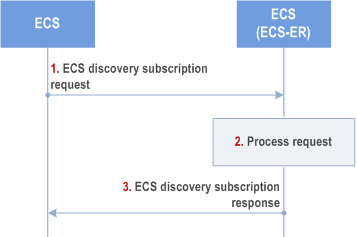
Step 1.
The ECS sends a ECS discovery subscription request to the ECS-ER. The request contains security information of the ECS. The request optionally contains AC profile(s), UE's location information and the PLMN information.
Step 2.
The ECS-ER authorizes the received request. If authorized, the ECS-ER creates and stores the subscription.
Step 3.
The ECS-ER sends a ECS discovery subscription response to the ECS which includes the subscription identifier and may include the expiration time, indicating when the subscription will automatically expire. To maintain the subscription, the EEC shall send a ECS discovery subscription update request prior to the expiration time. If a ECS discovery subscription update request is not received prior to the expiration time, the ECS-ER shall treat the ECS as implicitly unsubscribed.
8.17.2.3.3.3 Notify p. 257
Figure 8.17.2.3.3.3-1 illustrates the procedure.
Pre-conditions:
- The ECS has subscribed for ECS discovery.
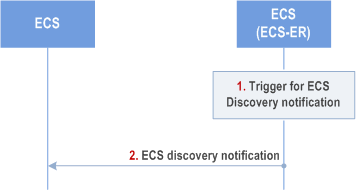
Step 1.
An event occurs at the ECS-ER that satisfies trigger conditions for ECS discovery notification, e.g. after new ECS registration.
Step 2.
The ECS-ER sends a ECS discovery notification to the ECS. The notification includes the ECS profile of the Partner ECS(s) as requested in the subscription and may include information for roaming UEs to establish a PDU session to the Partner ECS as specified in TS 23.548. The ECS caches the information for further use.
8.17.2.3.3.4 Subscription update p. 258
Figure 8.17.2.3.3.4-1 illustrates the procedure.
Pre-conditions:
- The ECS has subscribed for ECS discovery.
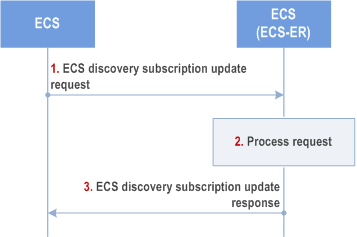
Step 1.
The ECS sends a ECS discovery subscription update request to the ECS-ER. The request contains security information of the ECS and may include an AC profile(s), UE's location information and the PLMN information.
Step 2.
The ECS-ER authorizes the received request. If authorized, the ECS-ER updates the stored subscription.
Step 3.
The ECS-ER sends an ECS discovery subscription update response indicating success or failure of the subscription update operation. The ECS-ER may provide an updated expiration time to indicate to the ECS when the updated subscription will automatically expire. To maintain the subscription, the ECS needs to send another subscription update request prior to the expiration time. If a subscription update request is not received prior to the expiration time, the ECS-ER treats the ECS as implicitly unsubscribed.
8.17.2.3.3.5 Unsubscribe p. 258
Figure 8.17.2.3.3.5-1 illustrates the procedure.
Pre-conditions:
- The ECS has subscribed for ECS discovery.
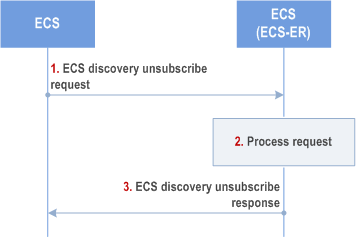
Step 1.
The ECS sends a ECS discovery unsubscribe request to the ECS-ER. The request contains security information of the ECS and the subscription identifier.
Step 2.
The ECS-ER authorizes the received request. If authorized, the ECS-ER cancels the stored subscription.
Step 3.
The ECS-ER sends an ECS unsubscribe response indicating success or failure of the subscription update operation.
8.17.2.4 Service provisioning information retrieval p. 259
8.17.2.4.1 General p. 259
When required to retrieve Service provisioning information from a partner ECS, the ECS queries the partner ECS by providing information such as required applications, location, service continuity support information and connectivity information. In response the partner ECS provides Service provisioning information of EDNs satisfying the requirements.
The following clauses specify procedures, information flows and APIs for service provisioning information retrieval.
In the following procedures, ECS sending the request can be an ECS-ER of an ECSP and Partner ECS receiving the request can be the ECS-ER of the partner ECSP.
8.17.2.4.2 Procedures p. 259
8.17.2.4.2.1 General p. 259
Following procedures are supported for service provisioning:
- Request-response model; and
- Subscribe-notify model.
8.17.2.4.2.2 Request-response model p. 259
Figure 8.17.2.4.2.2-1 illustrates service provisioning procedure based on request/response model.
Pre-conditions:
- ECS has received a service provisioning request from an EEC or T-EES discovery request from an EES.
- The ECS has the ECS profile of the partner ECS (e.g. through pre-configuration, OAM configuration or ECS discovery).
- Required federation agreement exists between the ECSPs.
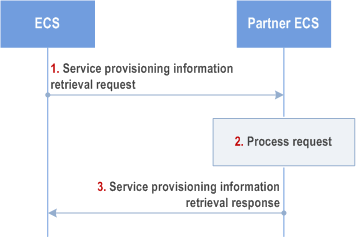
Step 1.
The ECS sends a service provisioning information retrieval request to the partner ECS. The request contains security information of the ECS, and optionally AC profile(s) and UE's current location. If the UE hosting the EEC is roaming in a V-PLMN (determined using the serving PLMN information in the received service provisioning request, or by interacting with the H-PLMN), then the service provisioning information retrieval request includes the information of the serving PLMN i.e. the V-PLMN.
Step 2.
The partner ECS authorizes the received request. If authorized, the partner ECS processes the request and gathers the provisioning information of the EDNs that can satisfy the query parameters received in step 1.
Step 3.
The partner ECS sends a service provisioning information retrieval response to the ECS. The response includes provisioning information of the EDNs that can satisfy the query parameters received in step 1 and may include lifetime information. The ECS caches the received information for further use. If the Lifetime IE is included, then the ECS may reuse the retrieved information only for the duration specified by the Lifetime IE, without the need to repeat step 1. When Application group profile is provided in the request for common EAS, procedure as described in clause 8.3.3.2.2 applies.
8.17.2.4.2.3 Subscribe-notify model p. 260
Void.
Figure 8.17.2.4.2.3.2-1 illustrates service provisioning information subscription request between an ECS and its partner ECS.
Pre-conditions:
- The ECS has the ECS configuration information of the partner ECS (e.g. through pre-configuration, OAM configuration or ECS discovery).
- Required federation agreement exists between the ECSPs.
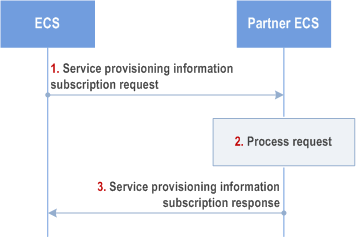
Step 1.
The ECS sends a service provisioning information subscription request to the partner ECS. The request contains security information of the ECS, Notification Target Address (e.g. URL), federation information, Service Provisioning filters.
Step 2.
The partner ECS authorizes the received request. If authorized, the partner ECS creates a subscription and stores the subscription.
Step 3.
The partner ECS sends a service provisioning information subscription response to the ECS. The response includes the subscription identifier and may include the expiration time, indicating when the subscription will automatically expire. To maintain the subscription, the ECS shall send a service provisioning information subscription update request prior to the expiration time. If a service provisioning information subscription update request is not received prior to the expiration time, the partner ECS shall treat the ECS as implicitly unsubscribed.
Figure 8.17.2.4.2.3.3-1 illustrates the service provisioning information notification procedure between an ECS and its partner ECS.
Pre-conditions:
- ECS has subscribed for service provisioning information from the partner ECS as specified in clause 8.17.2.4.2.3.2.
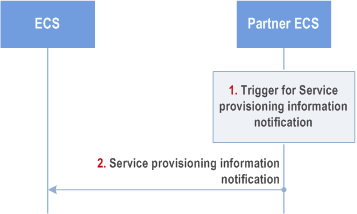
Step 1.
An event occurs at the partner ECS that satisfies trigger conditions for notifying (e.g. to provide a change in information about available EASs) a subscribed ECS.
Step 2.
The Partner ECS sends a service provisioning information notification to the ECS. The notification includes updated provisioning information of the EDNs that can satisfy the query parameters received during subscription and may include lifetime information. The ECS caches the received information for further use. If the Lifetime IE is included, then the ECS may reuse the received information only for the duration specified by the Lifetime IE.
Figure 8.17.2.4.2.3.4-1 illustrates service provisioning information subscription update request between an ECS and its partner ECS.
Pre-conditions:
- ECS has subscribed for service provisioning information from the partner ECS as specified in clause 8.17.2.4.2.3.2.
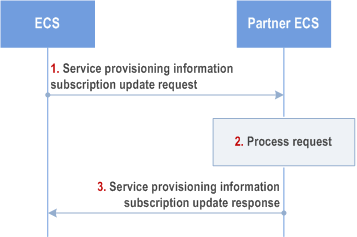
Step 1.
The ECS sends a service provisioning information subscription update request to the partner ECS. The request contains security information of the ECS and subscription identifier, and may include updated Notification Target Address (e.g. URL), federation information, Service Provisioning filters, location information and PLMN information.
Step 2.
The partner ECS authorizes the received request. If authorized, the partner ECS updates the stored subscription.
Step 3.
The partner ECS sends a service provisioning information subscription update response to the ECS. The response may include updated expiration time, indicating when the subscription will automatically expire. To maintain the subscription, the ECS shall send a service provisioning information subscription update request prior to the expiration time. If a service provisioning information subscription update request is not received prior to the expiration time, the partner ECS shall treat the ECS as implicitly unsubscribed.
Figure 8.17.2.4.2.3.5-1 illustrates service provisioning subscription update request between an ECS and its partner ECS.
Pre-conditions:
- ECS has subscribed for service provisioning information from the partner ECS as specified in clause 8.17.2.4.2.3.2.
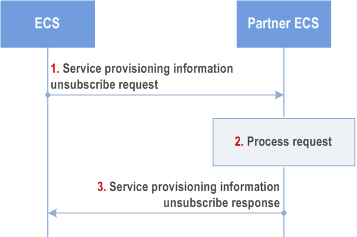
Step 1.
The ECS sends a service provisioning information unsubscribe request to the partner ECS. The request contains security information of the ECS and the subscription identifier.
Step 2.
The partner ECS authorizes the received request. If authorized, the partner ECS cancels the subscription.
Step 3.
The partner ECS sends a service provisioning information unsubscribe response to the ECS.